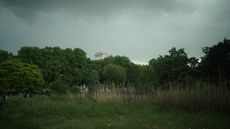Nan Goldin documentary is a gritty tale of addiction, resilience, and battles with the Sackler family
Released in the UK on 27 January, ‘All the Beauty and the Bloodshed’ by director Laura Poitras chronicles acclaimed photographer Nan Goldin’s complex life, work, and tireless activism to hold power to account.

The opening scene of All the Beauty and the Bloodshed begins in 2018 at the Egyptian Temple of Dendur in The Met Museum in New York. There, Nan Goldin is leading activists from P.A.I.N. (Prescription Addiction Intervention Now) in a protest in what was then the museum’s Sackler Wing, named after the pharmaceutical dynasty widely criticised for its role in America’s opioid crisis. They shout ‘shame’ and throw pill bottles, labelled with ‘prescribed to you by the Sackler Family’, into the museum’s indoor moat.
This sets the tone for a documentary that blends art and activism to blistering effect. Directed by Academy Award-winner Laura Poitras, the film became the second documentary to receive the coveted Golden Lion award at the Venice Film Festival in 2022 and currently sits on the shortlist for Best Documentary Feature Film at the 95th Academy Awards (winners announced 12 March 2023).
‘All the Beauty and the Bloodshed’: power and resistance

Poitras’ film deftly bookends and interweaves the life and work of Goldin with her tireless activism, stories of personal agony, and how she's used creativity as a tool for change. Power and resistance are recurring themes, past and present. Goldin’s early work – photographic chronicles of life in Boston’s gay and transgender communities – was met with hostility particularly, as she notes in the film, from male artists and gallerists.
In 1986, she curated the controversial landmark group exhibition ‘Witnesses: Against Our Vanishing’. The subject of national controversy, it was the first show to exclusively confront the Aids epidemic – during which Goldin lost close friends – and its social stigma.

Nan and Barbara holding hands; Goldin and her sister as children
The same year, Goldin would create her best-known work, The Ballad of Sexual Dependency (1986). It captures the off-guard extremes of human nature: the ecstasy, agony, love, sex, drugs and domestic violence in Goldin's social circle, all captured on 35mm slideshows. The deeply personal narrative continues as Goldin recounts how she was addicted to the opioid painkiller OxyContin in 2014. ‘My anger at the Sackler family is personal,’ she says in the film. ‘When you think of the profit of people’s pain, you can only be furious.’
At its heart, this is a film about family: Nan Goldin’s own family and childhood challenges, which involved her sister’s tragic suicide; and the familial 1980s communities and LGBT subcultures that Goldin immersed herself in and would base her most defining work on. And then came her battles with the Sackler family. The film chronicles how, since 2017, Goldin has been campaigning to scratch off the veneer of philanthropic nobility to expose the truth and hold power to account.

The Sacklers owned and operated Purdue Pharma, the (now-bankrupt) company that sold OxyContin, a high-strength, highly addictive painkiller that arguably fuelled the opioid epidemic. The opioid crisis led to the deaths of around half a million Americans over two decades through overdose (1999 – 2020, as detailed in a hearing published by the US government). Simultaneously, the Sackler family was prolific in offering handsome donations to arts institutions, its name stamped on wings and lobbies of global museums. Since Goldin’s activism began, global museums including the V&A, Tate, and the Louvre have dropped financial ties with the Sackler family. As Reuters reported in March 2022, the Sacklers paid $6 billion to resolve litigation alleging that OxyContin fuelled the US opioid crisis.
Poitras’ epic ends back at The Met’s Egyptian Temple of Dendur. It’s now 2021, and the Sackler name has just been erased from the glass pane above the entrance. It’s a potent end to an agonising journey of loss, resilience and the journey to justice.
‘All the Beauty and the Bloodshed’ will be released in UK cinemas on 27 January 2023.
The documentary coincides with ‘This Will Not End Well’, Goldin’s major retrospective, which runs until 26 February 2023 at Moderna Museet, Stockholm, before travelling to the Stedelijk Museum in Amsterdam, the Neue Nationalgalerie in Berlin, and Pirelli HangarBicocca Milan.
Wallpaper* Newsletter
Receive our daily digest of inspiration, escapism and design stories from around the world direct to your inbox
Harriet Lloyd-Smith was the Arts Editor of Wallpaper*, responsible for the art pages across digital and print, including profiles, exhibition reviews, and contemporary art collaborations. She started at Wallpaper* in 2017 and has written for leading contemporary art publications, auction houses and arts charities, and lectured on review writing and art journalism. When she’s not writing about art, she’s making her own.
-
 Iné in Hampstead is a Japanese restaurant with a contemporary touch
Iné in Hampstead is a Japanese restaurant with a contemporary touchIné in London's Hampstead reflects edomae traditions, offering counter omakase and à la carte dining in a minimalist, contemporary setting
By Ellie Stathaki Published
-
 Jonathan Baldock’s playful works bring joy to Yorkshire Sculpture Park
Jonathan Baldock’s playful works bring joy to Yorkshire Sculpture ParkJonathan Baldock mischievously considers history and myths in ‘Touch Wood’ at Yorkshire Sculpture Park
By Anne Soward Published
-
 House of Greens in India’s Bengaluru is defined by its cascading foliage
House of Greens in India’s Bengaluru is defined by its cascading foliageNestled in Bengaluru’s suburbs, House of Greens by 4site Architects encourages biophilic architecture by creating a pleasantly leafy urban jungle
By Tianna Williams Published
-
 Heads up for London Film Festival 2023’s immersive art programme
Heads up for London Film Festival 2023’s immersive art programmeFrom VR fungi to AR walks, London Film Festival 2023 announces LFF Expanded, a compelling programme of immersive art and extended realities
By Tianna Williams Published
-
 John Waters on his weird and wonderful world, celebrated in new LA exhibition
John Waters on his weird and wonderful world, celebrated in new LA exhibitionThe cult filmmaker invites us into his studio ahead of ‘John Waters: Pope of Trash’, at LA’s Academy Museum of Motion Pictures (from 17 September)
By Hunter Drohojowska-Philp Published
-
 Asteroid City behind the scenes: How the world fell under Wes Anderson’s retro-tinted spell
Asteroid City behind the scenes: How the world fell under Wes Anderson’s retro-tinted spellWe peek behind the scenes of Wes Anderson’s new film Asteroid City, and explore how the world has gone barmy for the American filmmaker’s pastel-hued aesthetic
By Jessica Klingelfuss Last updated
-
 Steve McQueen to screen his harrowing film 'Grenfell' at London’s Serpentine
Steve McQueen to screen his harrowing film 'Grenfell' at London’s SerpentineAcclaimed film director and artist Steve McQueen will screen his film, Grenfell, at London’s Serpentine South gallery (7 April-10 May 2023), six years after the Grenfell Tower block blaze killed 72
By Harriet Lloyd-Smith Published
-
 Baz Luhrmann on creativity, that iconic scene in Romeo + Juliet, and collaborating with Bombay Sapphire
Baz Luhrmann on creativity, that iconic scene in Romeo + Juliet, and collaborating with Bombay SapphireWe speak to legendary film director and creative maestro Baz Luhrmann for the launch of ‘Saw This Made This’, his latest campaign with gin label Bombay Sapphire
By Jessica Klingelfuss Last updated
-
 Artist Julianknxx on poetry, dreams and Switzerland
Artist Julianknxx on poetry, dreams and SwitzerlandAhead of the New York showing of his major new film with Switzerland Tourism, we visit the studio of London-based poet and filmmaker Julianknxx
By Jessica Klingelfuss Last updated
-
 Huw Lemmey navigates sex, politics and espionage in new film
Huw Lemmey navigates sex, politics and espionage in new filmUngentle is a fictional journey through 20th-century Britain, exploring the relationship between espionage and male homosexuality. A collaboration between Huw Lemmey and Onyeka Igwe, the film is on view at London’s Studio Voltaire in September
By Davy Pittoors Last updated
-
 Fondazione In Between Art Film: a cinematic celebration of time-based media in Venice
Fondazione In Between Art Film: a cinematic celebration of time-based media in VeniceBeatrice Bulgari’s new foundation, championing time-based media, takes over a disused hospital with a surreal group exhibition during the Venice Biennale 2022
By Amah-Rose Abrams Last updated










